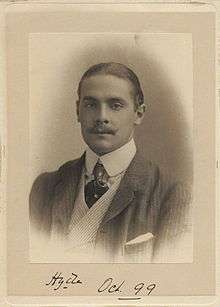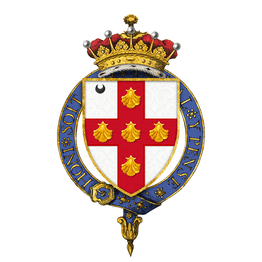George Villiers, 6th Earl of Clarendon
George Herbert Hyde Villiers, 6th Earl of Clarendon, KG GCMG GCVO PC DL (7 June 1877 – 13 December 1955), styled Lord Hyde from 1877 to 1914, was a British Conservative politician from the Villiers family. He served as Governor-General of the Union of South Africa from 1931 to 1937.
The Earl of Clarendon | |
|---|---|
 | |
| 5th Governor-General of South Africa | |
| In office 26 January 1931 – 5 April 1937 | |
| Monarch | George V Edward VIII George VI |
| Prime Minister | James Barry Munnik Hertzog |
| Preceded by | The Earl of Athlone |
| Succeeded by | Sir Patrick Duncan |
| Personal details | |
| Born | George Herbert Hyde Villiers 7 June 1877 |
| Died | 13 December 1955 (aged 78) |
| Nationality | British |
| Political party | Conservative |
| Spouse(s) | Adeline Verena Isabel Cocks |
| Occupation | Politician, Colonial administrator |

Background
Clarendon was the only son of Edward Hyde Villiers, 5th Earl of Clarendon and his wife Lady Caroline Elizabeth Agar, daughter of James Agar, 3rd Earl of Normanton. George William Frederick Villiers, 4th Earl of Clarendon, three times Foreign Secretary, was his grandfather.
Political career
Clarendon took his seat on the Conservative benches in the House of Lords on his father's death in 1914. When Bonar Law became Prime Minister in 1922 he appointed Clarendon Captain of the Honourable Corps of Gentlemen-at-Arms (government chief whip in the House of Lords), a position he also held under Stanley Baldwin until January 1924, and again from December 1924 to 1925. He then served as the first Under-Secretary of State for Dominion Affairs until 1927. In 1931 Clarendon was appointed Governor-General of South Africa, in which position he remained until 1937. During his tenure as Governor-General of South Africa, he also served as Chief Scout of South Africa.[1] Clarendon High School for Girls and its associated schools, Clarendon Primary School and Clarendon Preparatory School in East London, South Africa are named after him.[2]
Clarendon was later Lord Chamberlain of the Household between 1938 and 1952. He was sworn of the Privy Council in 1931 and made a Knight of the Garter in 1937.
Family
Lord Clarendon married Adeline Verena Ishbel Cocks, daughter of Herbert Haldane Somers Cocks, in 1905.[3]
They had three children:
- George Villiers, Lord Hyde, killed in a shooting accident in South Africa in 1935, leaving a son George Frederick Laurence and a posthumous daughter, Rosemary. [4]
- (Nina) Joan Villiers, Lady Newman
- (William) Nicholas Villiers. His daughter, Elizabeth, became the first god-daughter of Queen Elizabeth II.[5]
He died in December 1955, aged 78. His eldest son George Villiers, Lord Hyde, had been killed in a shooting accident in 1935; the earldom was inherited by George's son Laurence.
Honours


.svg.png)


_ribbon_-vector.svg.png)


References
- Wilson, John S. (1959). Scouting Round the World (1st ed.). Blandford Press. p. 94.
- "Clarendon Primary". Archived from the original on 27 September 2007. Retrieved 21 August 2007.
- "Person Page". www.thepeerage.com.
- "Lady Rosemary Steel 1935-2018". Peerage News.
- "'Nappy and glorious'". Daily Mail. 1 June 2012.
- Council, Watford Borough. "Who is the Chairman?". www.watford.gov.uk.
External links
- Hansard 1803–2005: contributions in Parliament by the Earl of Clarendon
| Political offices | ||
|---|---|---|
| Preceded by The Lord Ranksborough |
Lord-in-waiting 1921 – 1922 |
New government |
| Preceded by The Lord Colebrooke |
Captain of the Gentlemen-at-Arms 1922 – 1924 |
Succeeded by The Earl of Dunmore |
| Preceded by The Lord Colebrooke and The Lord Hylton |
Government Chief Whip in the House of Lords 1922 – 1924 |
Succeeded by The Lord Muir-Mackenzie |
| Preceded by The Earl of Dunmore |
Captain of the Gentlemen-at-Arms 1924 – 1925 |
Succeeded by The Earl of Plymouth |
| Preceded by The Lord Muir-Mackenzie |
Government Chief Whip in the House of Lords 1924 – 1925 | |
| New office | Under-Secretary of State for Dominion Affairs 1925 – 1927 |
Succeeded by The Lord Lovat |
| Preceded by The Earl of Athlone |
Governor-General of South Africa 1931 – 1937 |
Succeeded by Sir Patrick Duncan |
| Court offices | ||
| Preceded by The Earl of Cromer |
Lord Chamberlain 1938 – 1952 |
Succeeded by The Earl of Scarbrough |
| Media offices | ||
| Preceded by Jack Pease |
Chairman of the BBC Board of Governors 1927–1930 |
Succeeded by John Henry Whitley |
| Peerage of Great Britain | ||
| Preceded by Edward Villiers |
Earl of Clarendon 1914 – 1955 |
Succeeded by George Villiers |
.svg.png)
.svg.png)